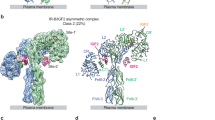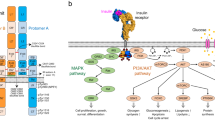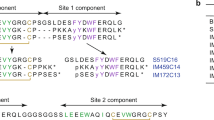Abstract
The insulin receptor (IR) family is a subfamily of receptor tyrosine kinases that controls metabolic homeostasis and cell growth. Distinct from IR and insulin-like growth factor 1 receptor, whose activation requires ligand binding, insulin receptor-related receptor (IRR)—the third member of the IR family—is activated by alkaline pH. However, the molecular mechanism underlying alkaline pH-induced IRR activation remains unclear. Here, we present cryo-EM structures of human IRR in both neutral pH inactive and alkaline pH active states. Combined with mutagenesis and cellular assays, we show that, upon pH increase, electrostatic repulsion of the pH-sensitive motifs of IRR disrupts its autoinhibited state and promotes a scissor-like rotation between two protomers, leading to a T-shaped active conformation. Together, our study reveals an unprecedented alkaline pH-dependent activation mechanism of IRR, opening up opportunities to understand the structure–function relationship of this important receptor.
This is a preview of subscription content, access via your institution
Access options
Access Nature and 54 other Nature Portfolio journals
Get Nature+, our best-value online-access subscription
$29.99 / 30 days
cancel any time
Subscribe to this journal
Receive 12 print issues and online access
$189.00 per year
only $15.75 per issue
Buy this article
- Purchase on Springer Link
- Instant access to full article PDF
Prices may be subject to local taxes which are calculated during checkout




Similar content being viewed by others
Data availability
All reagents generated in this study are available with a completed Materials Transfer Agreement. All cryo-EM maps and models reported in this work have been deposited with the PDB/EMDB database, under the entry ID: PDB 7TYJ/EMD-26181, PDB 7TYK/EMD-26183 and PDB 7TYM/EMD-26185. PDB used in this study are as follows: PDB 4ZXB, PDB 6PXV, PDB 5U8R and PDB 6PYH. Source data are provided with this paper.
References
Ullrich, A. et al. Human insulin receptor and its relationship to the tyrosine kinase family of oncogenes. Nature 313, 756–761 (1985).
Shier, P. & Watt, V. M. Primary structure of a putative receptor for a ligand of the insulin family. J. Biol. Chem. 264, 14605–14608 (1989).
Abbott, A. M., Bueno, R., Pedrini, M. T., Murray, J. M. & Smith, R. J. Insulin-like growth factor I receptor gene structure. J. Biol. Chem. 267, 10759–10763 (1992).
Jui, H. Y., Suzuki, Y., Accili, D. & Taylor, S. I. Expression of a cDNA encoding the human insulin receptor-related receptor. J. Biol. Chem. 269, 22446–22452 (1994).
Ebina, Y. et al. The human insulin receptor cDNA: the structural basis for hormone-activated transmembrane signalling. Cell 40, 747–758 (1985).
Ullrich, A. et al. Insulin-like growth factor I receptor primary structure: comparison with insulin receptor suggests structural determinants that define functional specificity. EMBO J. 5, 2503–2512 (1986).
Accili, D. et al. Early neonatal death in mice homozygous for a null allele of the insulin receptor gene. Nat. Genet. 12, 106–109 (1996).
Nef, S. et al. Testis determination requires insulin receptor family function in mice. Nature 426, 291–295 (2003).
Haeusler, R. A., McGraw, T. E. & Accili, D. Biochemical and cellular properties of insulin receptor signalling. Nat. Rev. Mol. Cell Biol. 19, 31–44 (2018).
Olefsky, J. M. The insulin receptor: its role in insulin resistance of obesity and diabetes. Diabetes 25, 1154–1162 (1976).
De Meyts, P. The structural basis of insulin and insulin-like growth factor-I receptor binding and negative co-operativity, and its relevance to mitogenic versus metabolic signalling. Diabetologia 37, S135–148 (1994).
Pollak, M. The insulin and insulin-like growth factor receptor family in neoplasia: an update. Nat. Rev. Cancer 12, 159–169 (2012).
Joshi, R. L. et al. Targeted disruption of the insulin receptor gene in the mouse results in neonatal lethality. EMBO J. 15, 1542–1547 (1996).
Hernandez-Sanchez, C., Mansilla, A., de Pablo, F. & Zardoya, R. Evolution of the insulin receptor family and receptor isoform expression in vertebrates. Mol. Biol. Evol. 25, 1043–1053 (2008).
Kurachi, H., Jobo, K., Ohta, M., Kawasaki, T. & Itoh, N. A new member of the insulin receptor family, insulin receptor-related receptor, is expressed preferentially in the kidney. Biochem. Biophys. Res. Commun. 187, 934–939 (1992).
Shier, P. & Watt, V. M. Tissue-specific expression of the rat insulin receptor-related receptor gene. Mol. Endocrinol. 6, 723–729 (1992).
Zhang, B. & Roth, R. A. The insulin receptor-related receptor. Tissue expression, ligand binding specificity, and signaling capabilities. J. Biol. Chem. 267, 18320–18328 (1992).
Kitamura, T. et al. Preserved pancreatic beta-cell development and function in mice lacking the insulin receptor-related receptor. Mol. Cell. Biol. 21, 5624–5630 (2001).
Tsujimoto, K., Tsuji, N., Ozaki, K., Ohta, M. & Itoh, N. Insulin receptor-related receptor messenger ribonucleic acid in the stomach is focally expressed in the enterochromaffin-like cells. Endocrinology 136, 558–561 (1995).
Raizada, M. K. Insulin receptor-related receptor: an orphan with neurotrophic/neuromodulatory potential. Endocrinology 133, 1–2 (1993).
Deyev, I. E. et al. Insulin receptor-related receptor as an extracellular alkali sensor. Cell Metab. 13, 679–689 (2011).
Petrenko, A. G., Zozulya, S. A., Deyev, I. E. & Eladari, D. Insulin receptor-related receptor as an extracellular pH sensor involved in the regulation of acid-base balance. Biochim. Biophys. Acta 1834, 2170–2175 (2013).
Scapin, G. et al. Structure of the insulin receptor-insulin complex by single-particle cryo-EM analysis. Nature 556, 122–125 (2018).
Weis, F. et al. The signalling conformation of the insulin receptor ectodomain. Nat. Commun. 9, 4420 (2018).
Li, J., Choi, E., Yu, H. & Bai, X. C. Structural basis of the activation of type 1 insulin-like growth factor receptor. Nat. Commun. 10, 4567 (2019).
Uchikawa, E., Choi, E., Shang, G., Yu, H. & Bai, X. C. Activation mechanism of the insulin receptor revealed by cryo-EM structure of the fully liganded receptor-ligand complex. eLife 8, e48630 (2019).
Gutmann, T. et al. Cryo-EM structure of the complete and ligand-saturated insulin receptor ectodomain. J. Cell Biol. 219, e201907210 (2020).
Li, J. et al. Synergistic activation of the insulin receptor via two distinct sites. Nat. Struct. Mol. Biol. 29, 357–368 (2022).
Li, J., Wu, J., Hall, C., Bai, X. C. & Choi, E. Molecular basis for the role of disulfide-linked alphaCTs in the activation of insulin-like growth factor 1 receptor and insulin receptor. eLife 11, e81286 (2022).
Park, J. et al. Activation of the insulin receptor by an insulin mimetic peptide. Nat. Commun. 13, 5594 (2022).
Bai, X. C., Rajendra, E., Yang, G., Shi, Y. & Scheres, S. H. Sampling the conformational space of the catalytic subunit of human gamma-secretase. eLife 4, e11182 (2015).
Li, J. et al. Cryo-EM analyses reveal the common mechanism and diversification in the activation of RET by different ligands. eLife 8, e47650 (2019).
McKern, N. M. et al. Structure of the insulin receptor ectodomain reveals a folded-over conformation. Nature 443, 218–221 (2006).
Xu, Y. et al. How ligand binds to the type 1 insulin-like growth factor receptor. Nat. Commun. 9, 821 (2018).
Pace, C. N., Grimsley, G. R. & Scholtz, J. M. Protein ionizable groups: pK values and their contribution to protein stability and solubility. J. Biol. Chem. 284, 13285–13289 (2009).
Morales-Perez, C. L., Noviello, C. M. & Hibbs, R. E. Manipulation of subunit stoichiometry in heteromeric membrane proteins. Structure 24, 797–805 (2016).
Uchikawa, E., Chen, Z., Xiao, G. Y., Zhang, X. & Bai, X. C. Structural basis of the activation of c-MET receptor. Nat. Commun. 12, 4074 (2021).
Mastronarde, D. N. Automated electron microscope tomography using robust prediction of specimen movements. J. Struct. Biol. 152, 36–51 (2005).
Zheng, S. Q. et al. MotionCor2: anisotropic correction of beam-induced motion for improved cryo-electron microscopy. Nat. Methods 14, 331–332 (2017).
Zhang, K. Gctf: real-time CTF determination and correction. J. Struct. Biol. 193, 1–12 (2016).
Zivanov, J. et al. New tools for automated high-resolution cryo-EM structure determination in RELION-3. eLife 7, e42166 (2018).
Emsley, P., Lohkamp, B., Scott, W. G. & Cowtan, K. Features and development of Coot. Acta Crystallogr. D. Biol. Crystallogr. 66, 486–501 (2010).
Liebschner, D. et al. Macromolecular structure determination using X-rays, neutrons and electrons: recent developments in Phenix. Acta Crystallogr. D. Struct. Biol. 75, 861–877 (2019).
Pettersen, E. F. et al. UCSF Chimera–a visualization system for exploratory research and analysis. J. Comput. Chem. 25, 1605–1612 (2004).
Acknowledgements
Cryo-EM data were collected at the University of Texas Southwestern Medical Center (UTSW) Cryo-Electron Microscopy Facility, funded in part by the Cancer Prevention and Research Institute of Texas (CPRIT) Core Facility Support Award RP170644. We thank D. Stoddard for facility access. This work is supported in part by grants from the National Institutes Health (R01GM136976 to X.-C.B., R35GM142937 to E.C. and a center grant P30DK063608), the Welch foundation (I-1944 to X.-C.B.), CPRIT (RP160082 to X.-C.B.) and the Alice Bohmfalk Charitable (to E.C.). X.-C.B. is Virginia Murchison Linthicum Scholars in Medical Research at UTSW.
Author information
Authors and Affiliations
Contributions
E.C. and X.-C.B. designed and supervised research; L.W., C.H., J.L., E.C. and X.-C.B. performed research, analyzed data and contributed to the writing of the paper.
Corresponding authors
Ethics declarations
Competing interests
The authors declare no competing interests.
Peer review
Peer review information
Nature Structural & Molecular Biology thanks Pierre De Meyts and the other, anonymous, reviewer(s) for their contribution to the peer review of this work. Peer reviewer reports are available. Sara Osman was the primary editor on this article and managed its editorial process and peer review in collaboration with the rest of the editorial team.
Additional information
Publisher’s note Springer Nature remains neutral with regard to jurisdictional claims in published maps and institutional affiliations.
Extended data
Extended Data Fig. 1 Sequence alignment of human IRR, IR and IGF1R.
The proposed key pH sensitive residues and the residues located in the interfaces of active-IRR are marked.
Extended Data Fig. 2 Purification of the extracellular domain of human IRR.
(a) A representative size-exclusion chromatogram of IRR at pH 7. The peak fractions were visualized on SDS–PAGE by Coomassie staining, in the absence or presence of dithiothreitol (DTT). This experiment was repeated for at least 5 times independently with similar results. (b) A representative size-exclusion chromatogram of IRR at pH 9. The peak fractions were visualized on SDS–PAGE by Coomassie staining, in the absence or presence of DTT. This experiment was repeated for at least 5 times independently with similar results.
Extended Data Fig. 3 Cryo-EM analysis of IRR at pH 7.
(a) Representative electron micrograph. This experiment was repeated for 4,410 times independently with similar results. Scale bar: 200 Å. (b) 2D class averages of IRR at pH 7. (c) Cryo-EM maps of IRR at pH 7 colored by local resolution. Up: the cryo-EM map refined with C2 symmetry applied. Bottom: the cryo-EM map refined with symmetry expansion and C1 symmetry. (d) Gold-standard Fourier shell correlation (FSC) curve for the cryo-EM maps. Blue: before symmetry expansion. Red: after symmetry expansion. (e) Flowchart of cryo-EM data processing of the dataset of IRR at pH 7.
Extended Data Fig. 4 Representative cryo-EM densities of various parts of the structures of apo- and active-IRR.
(a) Representative cryo-EM density of each domain of apo-IRR. (b) Representative cryo-EM density of each domain of active-IRR.
Extended Data Fig. 5 Sequence alignment of IRR.
The proposed key pH-sensitive residues are marked.
Extended Data Fig. 6 Effects of mutations at the interface between L1 and FnIII-2 domains in the apo-IRR.
(a) IR phosphorylation induced by insulin in 293FT cells expressing IR WT or the indicated mutants. (b) Quantification of the Western blot data shown in (a) (Mean ± SD). Each experiment was repeated three times. Significance calculated using two-tailed students t-test. *p = 0.0252. (c) Histidine residues at the L1/FnIII-2 interface in the apo-IRR. (d) IRR phosphorylation induced by alkaline media in 293FT cells expressing IRR WT or the indicated mutants. (e) Quantification of the Western blot data at pH 9.0 shown in (d) (Mean ± SD). Each experiment was repeated three times. Significance calculated using two-tailed student t-test. No significant difference was found. (f) The expression of mature (IRRβ) and proreceptor forms of IRR in 293FT cells expressing IRR wild-type (WT) or the indicated mutants. (g) Quantification of mature forms of IRR of the Western blot data (f) (Mean ± SD). Each experiment was repeated three times. Significance calculated using two-tailed students t-test. (h) Quantification of proreceptor forms of IRR of the Western blot data (f) (Mean ± SD). Each experiment was repeated three times. Significance calculated using two-tailed students t-test.
Extended Data Fig. 7 Cryo-EM analysis of IRR at pH 9.
(a) Representative electron micrograph. This experiment was repeated for 7,195 times independently with similar results. Scale bar: 200 Å. (b) 2D class averages of IRR at pH 9. (c) Cryo-EM map of IRR at pH 9 colored by local resolution, shown in two orthogonal views. (d) Gold-standard Fourier shell correlation (FSC) curve for the cryo-EM map. (e) Flowchart of cryo-EM data processing of the dataset of IRR at pH 9.
Extended Data Fig. 8 Three interfaces between two protomers stabilize the active IRR dimer.
(a) IRR phosphorylation induced by alkaline media in 293FT cells expressing IRR WT or the indicated mutants. Mutants were designed to abolish interaction at Interface I (L489E; L554E; K117E) or Interface II (R448A; H360A). (b) IRR phosphorylation induced by alkaline media in 293FT cells expressing IRR WT or the indicated mutants. Mutants were designed to abolish interaction at Interface III. Quantification of (a) and (b) is shown in Fig. 3f. (c) The locations of acidic residues from the pH-sensitive motif of IRR in the active state.
Extended Data Fig. 9 The protonation status of interface histidine does not affect the structural stability of a T-shaped IRR.
(a) Histidine residues at the protomer-protomer interface of the T-shaped, active structure of IRR. (b) IRR phosphorylation induced by alkaline media in 293FT cells expressing IRR WT or the indicated mutants. (c) Quantification of the Western blot data at pH 9.0 shown in (b) (Mean ± SD). Each experiment was repeated three times. Significance calculated using two-tailed student t-test. (Note that the quantification of H360A is the same as that in Fig. 3f).
Extended Data Fig. 10 The effect of insulin on IRR activation in different pH conditions.
(a) IRR phosphorylation induced by alkaline media in 293FT cells expressing IRR WT or indicated point mutants, which abolish site-1 insulin binding. pH treatment with serum-free DMEM at 7.4, 8.0, or 9.0; insulin treatment at 100 nM. (b) IRR phosphorylation induced by alkaline media in 293FT cells expressing IRR WT or indicated point mutants, which abolish site-2 insulin binding. pH treatment with serum-free DMEM at 7.4, 8.0, or 9.0; insulin treatment at 100 nM. (c) Quantification of Western blot data shown in (a) and (b) (Mean ± SD). WT, n = 6 independent experiments; E484K, n = 3; R486E, n = 3; R476E, n = 3; T535A, n = 3. Relative pY-IRR/Total IRR levels are normalized to IRR WT phosphorylation with pH 9.0 treatment, no insulin. No significant difference was found between + and – insulin conditions at the same pH for any mutant.
Supplementary information
Source data
Source Data Fig. 2
Statistical source data.
Source Data Fig. 2
Unprocessed western blots.
Source Data Fig. 3
Statistical source data.
Source Data Extended Data Fig. 6
Statistical source data.
Source Data Extended Data Fig. 6
Unprocessed western blots.
Source Data Extended Data Fig. 8
Unprocessed western blots.
Source Data Extended Data Fig. 9
Statistical source data.
Source Data Extended Data Fig. 9
Unprocessed western blots.
Source Data Extended Data Fig. 10
Statistical source data.
Source Data Extended Data Fig. 10
Unprocessed western blots.
Rights and permissions
Springer Nature or its licensor (e.g. a society or other partner) holds exclusive rights to this article under a publishing agreement with the author(s) or other rightsholder(s); author self-archiving of the accepted manuscript version of this article is solely governed by the terms of such publishing agreement and applicable law.
About this article
Cite this article
Wang, L., Hall, C., Li, J. et al. Structural basis of the alkaline pH-dependent activation of insulin receptor-related receptor. Nat Struct Mol Biol 30, 661–669 (2023). https://doi.org/10.1038/s41594-023-00974-0
Received:
Accepted:
Published:
Issue Date:
DOI: https://doi.org/10.1038/s41594-023-00974-0
This article is cited by
-
Activation of the insulin receptor by insulin-like growth factor 2
Nature Communications (2024)
-
Pendrin: linking acid base to blood pressure
Pflügers Archiv - European Journal of Physiology (2024)
-
How protons pave the way to aggressive cancers
Nature Reviews Cancer (2023)



